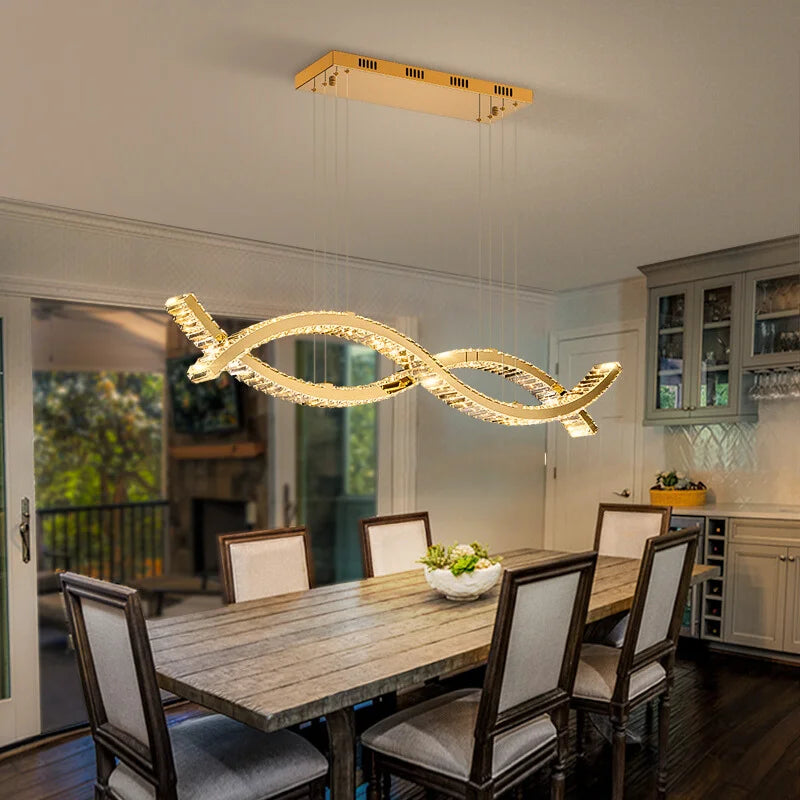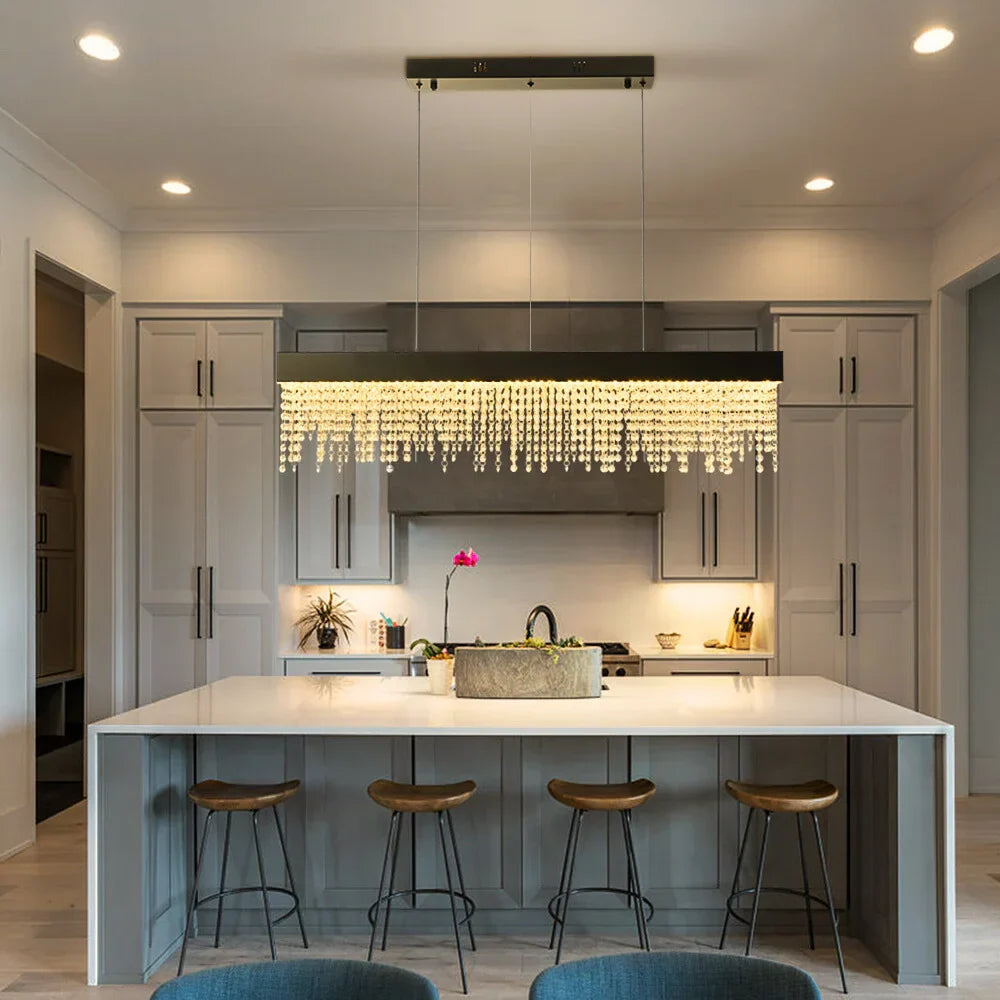Pendant lighting has become one of the most popular interior design elements for modern homes. Whether you're lighting up your kitchen island, dining area, or hallway, modern pendant lights add both function and style to your space. However, choosing the right size and perfect placement can be tricky, especially with the vast variety of contemporary light pendants available in today’s market.
This guide will walk you through everything you need to know about picking the perfect pendant light—covering size, spacing, height, and how to match the design with your space.
What Are Pendant Lights?
Pendant lights are single light fixtures that hang from the ceiling, usually suspended by a cord, chain, or metal rod. They come in a wide range of styles, shapes, materials, and sizes—making them a versatile lighting solution for different rooms and purposes.
Why Pendant Lighting Is So Popular
-
Versatility: Pendant lights work in kitchens, bedrooms, hallways, dining rooms, and even bathrooms.
-
Design Impact: With so many styles like modern pendant light options and contemporary pendant lights, they instantly add aesthetic appeal.
-
Focused Lighting: Ideal for task lighting or creating ambiance in specific areas.
-
Customizable: You can play with the height, number of fixtures, and style to suit your interior.
Understanding Pendant Light Sizes
Choosing the right size is crucial for both function and style. Here’s how to break it down:
1. Diameter (Width)
The width of the pendant light should be proportional to the space or furniture it’s above.
-
For a kitchen island, measure the island's width and divide it by the number of pendants you plan to hang, leaving about 6-12 inches between each fixture.
-
Over a dining table, the fixture should be around ⅔ the width of the table.
2. Height
The hanging height depends on the ceiling height and placement. General guidelines:
-
Above kitchen islands or countertops: 30–36 inches from the countertop to the bottom of the light.
-
Above a dining table: 28–34 inches from the table surface.
-
In open areas (e.g., hallways): At least 7 feet from the floor to the bottom of the fixture.
Placement Tips by Room
1. Kitchen
Use modern pendant lights in a row above the kitchen island. Ensure the fixtures are evenly spaced and not too low to block the view across the island.
Read also Top Contemporary Pendant Lights for Kitchen Islands in 2025.
2. Dining Room
A statement contemporary light pendant above the dining table can create a cozy atmosphere. Consider dimmable lighting for mood setting.
3. Living Room
Pendant lights can highlight a specific seating area or be used in groups to fill vertical space in high-ceiling areas.
4. Bedroom
Pendant lights on either side of the bed are modern alternatives to table lamps. They save space and create symmetry.
5. Hallways or Entryways
In a long hallway or entrance foyer, consider using multiple pendant lights spaced evenly or a dramatic large one to make a statement.
How Many Pendant Lights Do You Need?
A common mistake is either overcrowding or under-lighting a space. Here's how to estimate:
-
Kitchen Island: 2-3 medium-sized pendants for a standard 6-7 ft island.
-
Dining Table: One large centerpiece or a group of smaller pendants.
-
Open Rooms: Use visual balance to determine how many fixtures are needed.
Materials and Finishes
Modern pendant lights come in a variety of materials such as glass, metal, ceramic, wood, and fabric. The finish can be brushed nickel, black matte, gold, bronze, or chrome, allowing you to match your décor style.
-
Glass: Sleek and elegant, great for both traditional and modern spaces.
-
Metal: Ideal for industrial or modern aesthetics.
-
Fabric/Wood: Adds warmth and texture for bohemian or transitional styles.
Design Styles
When selecting contemporary pendant lights, match them with your overall design style:
-
Minimalist: Clean lines, neutral tones.
-
Industrial: Metal, exposed bulbs, rustic finishes.
-
Mid-century Modern: Geometric shapes, brass finishes.
-
Scandinavian: Simple designs, light wood, and soft diffused lighting.
Read also: 10 Stunning Modern Pendant Lights to Elevate Your Home in 2025
Lighting Type
-
Ambient: General lighting that brightens the entire room.
-
Task: Focused light for work areas like kitchen counters or reading nooks.
-
Accent: Decorative lighting to highlight a specific area or item.
Energy Considerations
Look for LED-compatible modern chandeliers and pendant lights. They’re energy-efficient, long-lasting, and come in various brightness levels and color temperatures.
How to Clean Your Pendant Light (Without Damaging It)
Pendant lights are beautiful statement pieces that elevate your space—whether they’re hanging above a kitchen island, dining area, or in your entryway. But over time, dust, grease, and grime can dull their shine. To keep your pendant lights looking brilliant and functioning efficiently, regular cleaning is essential.
Whether you have modern pendant lights, contemporary pendant lights, or delicate glass or metal fixtures, here’s how to clean them safely and effectively.
What You’ll Need:
-
A soft microfiber cloth or duster
-
Mild dish soap
-
Warm water
-
A soft sponge or non-abrasive cloth
-
Glass cleaner (optional)
-
Ladder or step stool
-
Screwdriver (if you need to remove the fixture)
-
Compressed air (for hard-to-reach spots)
Safety First: Turn Off the Power
Before you touch anything:
-
Switch off the light at the wall.
-
For extra safety, turn off the breaker at the electrical panel.
-
Let the bulbs cool down completely before cleaning.
Step-by-Step Cleaning Process
1. Dust the Fixture
Start with a gentle dry dusting using a microfiber cloth or feather duster. This removes loose debris from the surface of the modern pendant light.
Tip: Use compressed air for intricate parts or tight spaces.
2. Remove the Light Covers or Shades (if needed)
If your pendant light has a detachable shade or globe, carefully remove it. Check your manufacturer’s guide if you’re unsure how.
3. Clean with Soap and Water
-
Mix a few drops of mild dish soap with warm water.
-
Dip a soft sponge into the solution and gently clean the pendant, including metal parts and shades.
-
Avoid soaking electrical components.
4. Rinse and Dry
Rinse off soap with a clean damp cloth. Then dry with a soft towel or microfiber cloth to prevent water spots—especially on glass or shiny metal finishes.
5. Clean the Bulbs
Wipe bulbs gently with a dry cloth. Avoid using water or harsh chemicals directly on bulbs. This step can noticeably improve light output.
6. Reassemble and Turn Power Back On
Once everything is completely dry, reassemble your fixture and switch the power back on.
Tips for Different Pendant Light Materials
-
Glass Pendant Lights: Use glass cleaner for added sparkle, but avoid ammonia near metal finishes.
-
Metal Fixtures: Use a damp cloth and avoid abrasives that can scratch the finish.
-
Wood or Woven Shades: Dry dust only or use a slightly damp cloth—too much moisture can damage them.
-
Fabric Shades: Use a lint roller or vacuum with a brush attachment.
Maintenance Frequency
-
Light Dusting: Weekly
-
Deep Cleaning: Every 1–2 months
-
In Greasy Areas (like kitchens): Monthly
Common Mistakes to Avoid
-
Never spray cleaner directly onto the fixture—spray on the cloth instead.
-
Don’t use harsh chemicals or abrasive sponges.
-
Never clean while the light is on or hot.
Final Tips
-
Don’t forget to install a dimmer switch for adjustable ambiance.
-
Use multiple pendants in large rooms for balanced lighting.
-
Always measure your space before purchasing to avoid returns and frustration.
15 Frequently Asked Questions (FAQs)
1. How high should pendant lights be hung above a kitchen island?
30–36 inches from the countertop is standard.
2. How many pendant lights do I need for a 6-foot island?
Usually, two to three, spaced evenly.
3. What size pendant light is best for a small dining table?
A fixture that is about ⅔ the width of your table works best.
4. Are LED bulbs compatible with pendant lights?
Yes, most pendant lights today are LED-compatible.
5. Can I use pendant lights in the bathroom?
Yes, but ensure they are moisture-rated for safety.
6. Do pendant lights provide enough light for a room?
They can, especially when used in groups or paired with other lighting sources.
7. What’s the difference between pendant lights and chandeliers?
Pendant lights are typically single-light fixtures, while chandeliers have multiple lights branching from one unit.
8. Are contemporary pendant lights expensive?
They range in price depending on material and design. There are affordable and luxury options available.
9. What finishes are trending for modern pendant lights?
Matte black, brushed gold, and natural wood are very popular in 2025.
10. Do pendant lights need to be centered over furniture?
For aesthetics and balance, yes—it’s best to center them over tables, islands, or beds.
11. What is the standard size of a modern pendant light?
12 to 20 inches in diameter is common for medium-sized pendants.
12. Can I install pendant lights without an electrician?
It’s best to hire a professional for hardwired installations, especially if new wiring is involved.
13. Are dimmable pendant lights worth it?
Absolutely—they give you better control over mood and brightness.
14. What material is easiest to clean?
Glass and metal are easier to maintain than fabric or natural fiber options.
15. How do I clean contemporary pendant lights?
Turn off the power, remove dust with a soft cloth, and wipe with a damp cloth and mild soap if needed.
Conclusion
Choosing the right modern pendant light size and placement can elevate your entire space—functionally and visually. Whether you're leaning toward contemporary pendant lights for your kitchen or stylish modern chandeliers for a living room, it's all about balance, proportion, and smart placement. With this guide, you can select and install pendant lights that perfectly fit your space and style.








Share:
Top Contemporary Pendant Lights for Kitchen Islands in 2025